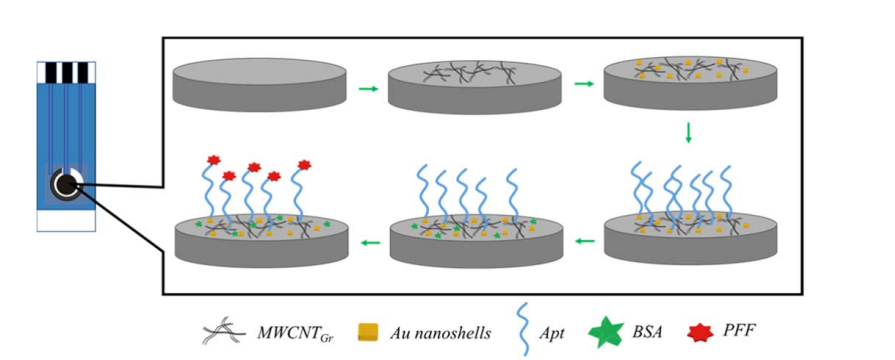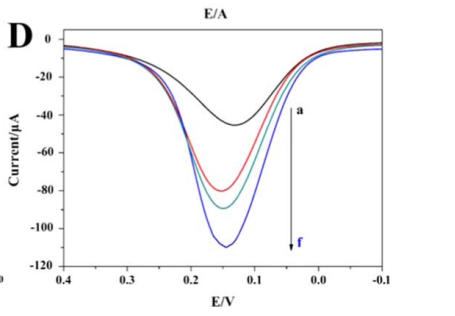文献:A Dual-Amplification Electrochemical Aptasensor for Profenofos Detection
文献链接:https://xueshu.baidu.com/usercenter/paper/show?paperid=1a2g0gv00e0x02901e4508s0e7545039&site=xueshu_se
作者:Hui Zhang,Jianfei Sun,Shuting Cheng,Huimin Liu,Falan Li, Yemin Guoand Xia Sun
相关产品:Au nanoshell 金纳米壳
原文摘要:The present study reported a dual-amplification electrochemical aptasensor for sensitive detection of profenofos (PFF) in vegetables. A screen-printed carbon electrode (SPCE) modified with graphitized multi-walled carbon nanotubes (MWCNTGr) and Au nanoshell was used as a test platform, which ensured a rapid detection process and showed a favorable electrochemical performance. MWCNTGr and Au nanoshell enhanced the electrical conductivity and the surface area, thus the detection signal was amplified. The affinity between PFF and its aptamer (Apt) was verified firstly by dot blot hybridization (DBH), and the result was exciting. Furthermore, the effects of the aptamers modified respectively with -NH2 and -SH on the current signal were compared with each other by cyclic voltammetry (CV), and results showed that the aptamers modified with -NH2 made the current signal change more obvious. Based on all above, a high-efficiency electrochemical aptasensor was fabricated with a wide linear range from 0.1–1 × 105 ng · ml−1 and a detection limit of 0.052 ng · ml−1 under the optimized conditions. This aptasensor had great specificity, stability and reproducibility. Hence, the developed aptasensor was successfully used to detect PFF in vegetables. The proposed method also has a potential for the detection of other organophosphorus pesticide (OPs).
金纳米壳主要由两部分组成,即中心的介电内核和外面包裹的金质外壳。介电内核可以是二氧化硅、聚苯乙烯等材料,金外壳的厚度通常在几纳米到几十纳米之间。这种核壳结构使得金纳米壳具有光学、电学和热学等特性。金纳米壳的整体尺寸一般在几十到几百纳米之间,内核半径和外壳厚度的不同组合会影响其性能。利用金纳米壳的表面等离子体共振特性,可以构建生物传感器,用于检测生物分子等。当目标分子与金纳米壳表面的配体结合时,会引起金纳米壳的光学性质发生变化,从而实现对目标分子的检测。采用石墨化多壁碳纳米管(MWCNTGr)和金纳米壳修饰的丝网印刷碳电极(SPCE)作为测试平台,保证了快速检测过程,并显示出良好的电化学性能。介绍一种双扩增电化学适应体传感器,用于敏感地检测蛋白质(PFF)。

图:适应传感器的制造程序
基于MWCNTGr和Au纳米壳测定PFF的适应传感器。MWCNTGr由于其巨大的导电性和特殊的结构,可以更紧密地修饰SPCE。MWCNTGr与金纳米壳结合可以有效提高自传感器的电活性。SPCE在处理方便和可移植的现场分析方面具有优势,为敏感地检测PFF提供了一个平台。该传感器具有较高的特异性、重现性和稳定性。

图:纳米壳/MWCNTGr/SPCE。
结论:MWCNTGr和Au纳米壳增强了电导率和比表面积,从而放大了检测信号。通过斑点杂交(DBH)验证了PFF与其适配体(Apt)之间的亲和力。采用循环伏安法(CV)比较了分别用-氨基和-SH修饰的适配体对电流信号的影响,结果表明,用-氨基修饰的适配体使电流信号的变化更加明显。在此基础上,在优化条件下制备了0.1~1~1×105 ng·ml−1,检测限为0.052 ng·ml−1。该适体传感器具有较强的特异性、稳定性和可重复性。

 2025-02-11 作者:ZJ 来源:
2025-02-11 作者:ZJ 来源:

